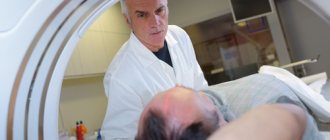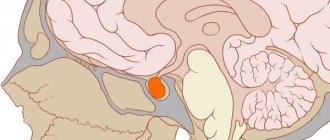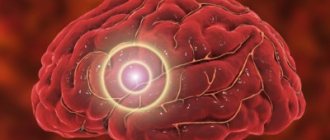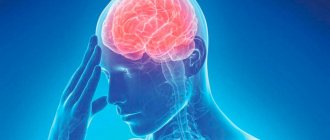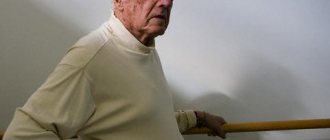Lacunar stroke is a type of ischemic form of apoplexy. According to statistics, it accounts for 22% of all cerebral infarctions (1). A characteristic sign of the pathology is the formation of small cavities (lacunae) at the site of necrosis, to which the disease owes its name.
Let us consider the features of the manifestation, course, diagnosis, treatment of lacunar stroke, typical consequences, and methods of prevention.
Features of the disease
In addition to its specific appearance, the lacunar form of infarction differs from other types of stroke in a number of specific features. The first is the small size of the lesion. The size of lacunar strokes ranges from 1 mm to 1.5-2 cm. Occasionally, larger areas of infarction (more than 2 cm), which are called giant, occur.
Often the disease is multiple. In one patient, from several dozen to hundreds of cavities can be found, giving the patient’s brain the appearance of a head of cheese. Typically, this anatomical picture is observed in elderly people and patients with diabetes mellitus. Multiple organ damage is the cause of senile dementia (dementia), Parkinson's disease, extensive hemorrhage, pseudobulbar symptom.
Single lacunae are also found, most often in women and young people (3).
The appearance of lacunae is associated with damage to small intracerebral arteries that run deep in the middle of the brain. Pathological cavities form around the affected vessel, so they do not affect the cortex of the organ. Due to this, higher functions (speech, memory, intellect) are rarely affected, other symptoms may be mild. This is the main reason why the disease cannot always be diagnosed during life.
Due to the blurred clinical picture, lacunar stroke is one of the most common incidental pathological findings during autopsy. In older, senile people suffering from hypertension, brain cavities are found in 11-26.6% of cases (2).
Main reasons
The occurrence of a stroke is always associated with arterial hypertension. Chronic exposure to high blood pressure causes various pinpoint damage to cerebral vessels, up to 1 cm in length:
- death of artery wall cells, leakage of fibrin into the affected area (fibrinoid necrosis);
- release of plasma from the bloodstream (plasmorrhagia);
- impregnation of the vessel wall with a specific protein, making it look like a glass tube (hyalinosis);
- replacement of the artery wall with connective tissue;
- fat deposition, usually without the formation of atherosclerotic plaques.
The nerve cells located around the affected artery begin to receive an inadequate amount of oxygen and nutrients. When their deficiency becomes critical, neurons die. Over time, a lacuna forms at the site of necrosis.
Another mechanism for the formation of cavities is typical for infarctions located at some distance along the main vessel. The middle layer of the artery consists of muscle cells - myocytes, which are destroyed under the influence of arterial hypertension. The vessel ceases to cope with pumping blood, its distant branches remain half-empty, which leads to necrosis of neurons.
Rarely, the death of neurons to form lacunae is caused by the rupture of tiny protrusions of brain vessels (aneurysms). This form of the disease belongs to the hemorrhagic subtypes of cerebrovascular accident.
Previously, it was believed that arterial hypertension was the only cause of lacunar stroke. More thorough studies have shown that in some patients, cerebral infarction develops as a consequence of a combination of atherosclerosis of the cerebral arteries and high blood pressure. But atherosclerotic lesions of the arteries themselves, which supply the brain, extremely rarely cause the formation of cavities.
Other risk factors for lacunar stroke (3):
- type 2 diabetes mellitus;
- alcohol abuse;
- smoking;
- suffered micro-strokes;
- elderly age.
What it is?
Lacunar stroke is characterized by the formation of lacunae in the deep parts of the brain. Their size varies between 1-15 millimeters in diameter.
Sometimes the lacunae merge with each other, forming larger lesions. They usually form in the following parts of the brain:
- in the optic thalamus;
- in white matter;
- in the pons;
- in the inner capsule;
- in the cerebellum.
The mechanism of lacunar stroke looks like this:
- Regular increases in blood pressure have a negative impact on the condition of blood vessels. Over time, they lose their firmness and elasticity, and fatty deposits accumulate in them.
- The lumen in the vessels gradually decreases, as a result of which there is no possibility for the required volume of blood to pass through.
- Blood circulation is disrupted, and insufficient oxygen and nutrients reach the brain cells.
- Tissue death gradually occurs.
- In necrotic areas, lacunae appear in the form of depressions.
It is important to know! The pathology causes disruption of the functioning of the musculoskeletal system and loss of sensitivity.
Symptoms, signs
All symptoms of the pathological process are divided into two large groups:
- general clinical signs - specific manifestations of stroke, by which a diagnosis can be made in most patients;
- disease syndromes are a typical combination of several disorders indicating the location of the lesion.
Common clinical signs are:
- the patient must have arterial hypertension;
- usually, a lacunar stroke occurs during sleep and is preceded by a headache and increased blood pressure;
- directly during the stroke, blood pressure is normal/slightly increased, no headache/mild, no drowsiness, lethargy or loss of consciousness;
- speech, reading and counting abilities are preserved;
- The deterioration of the condition occurs gradually, over several hours/days, often accompanied by temporary improvement.
Disease syndromes
| Name | Localization of the lesion |
| Pure motor stroke (50%) – paralysis of one half of the body | Internal capsule, pons, sometimes corona radiata, cerebral peduncle, rarely medulla oblongata |
| Pure sensory stroke (5%) – unilateral impairment of all or most types of sensitivity: pain, temperature, tactile | Thalamus, less commonly brainstem |
| Ataxic hemiparesis (10%) is a balance disorder accompanied by dizziness only clockwise/counterclockwise. The patient has difficulty making precise movements | Pons, internal capsule, cerebral peduncle |
| Sensory-motor stroke (35%) | Thalamus or internal capsule, less often – corona radiata, pons |
| Clumsiness in the hand and dysarthria are problems with purposeful, precise movements of the hand, speech disorders: a person has difficulty pronouncing individual sounds of words due to the inability to control the facial muscles. | Bridge, inner capsule |
| Hemichorea-hemiballismus is uncontrolled unilateral waving of an arm, leg, or head. | Lenticular nucleus, caudate nucleus |
| Isolated paralysis of the facial muscles - the lower part of the face on one side is distorted, forehead mobility (the ability to frown, raise eyebrows) is usually preserved. | Corona radiata, inner capsule |
Modern diagnostics
Conventional research methods - computer and magnetic resonance imaging - are not always able to detect lacunar ischemic stroke of the brain, especially with tiny lesions (less than 1 mm).
An experienced neurologist establishes a diagnosis and localization of the lesion using typical pathological markers:
- characteristic clinical picture, medical history;
- MRI does not reveal pathology, although the symptoms are clearly consistent with a stroke. On the 7th day of the disease, lesions can be visualized;
- angiography without abnormalities;
- the level of cerebrospinal fluid enzymes (creatine kinase, angiotensin converting enzyme, lactate dehydrogenase) is normal.
Features of treatment
There is no specific treatment for lacunar stroke. Doctors prescribe drugs to the patient that eliminate the main causes of a heart attack:
- antihypertensive drugs – normalize blood pressure;
- statins (atorvastatin, rosuvastatin, simvastatin) – reduce cholesterol levels;
- nootropics (piracetam, cerebrolysin, cinnarizine) – stimulate mental activity, improve memory, learning ability, increase stamina;
- microcirculation correctors (actovegin) – improve blood supply to the brain.
In addition to medication assistance for lacunar stroke, patients are recommended to work with a psychologist. During classes, the patient learns ways to deal with stress and fears. The specialist tries to help the patient come to terms with the new status, changes the mood, and relieves psychological stress. Relatives are also recommended to consult a psychologist to better understand the needs and problems of a loved one.
Ancillary methods of treating lacunar infarction include:
- physiotherapeutic procedures;
- acupressure;
- physical therapy.
Preparations for the restoration of nervous tissue
To shorten the recovery period after a lacunar stroke and ensure complete restoration of the nervous system, medications such as:
- nootropics - improve blood circulation in the brain, increase oxygen delivery to nerve cells and speed up metabolism (“Cerebrolysin”);
- multivitamin complexes - especially B vitamins, which have a beneficial effect on the nerves, in particular on their membrane;
- means for strengthening the vascular wall - "Trental".
Forecast and possible consequences
Of all forms of acute cerebrovascular accident with persistent symptoms, patients with lacunar stroke have the best prognosis. Death directly from the attack itself is extremely rare. According to the results of a global study, only 1.78% of patients die in the first 3.5 years (4). The worst prognosis is:
- elderly;
- patients with diabetes mellitus;
- high level of systolic pressure: every “extra” 20 mm Hg. increase the risk by 1.3 times;
- low hemoglobin level (less than 13 g/dl);
- decreased filtration capacity of the kidneys;
- high body mass index: increase in risk by 1.8 for every 10 kg/m2 above normal.
The consequences of lacunar infarction are associated with impaired mobility, sensitivity, and coordination. The violations are usually mild and often go unnoticed by patients and doctors. Typically, patients manage to fully recover within a period of several weeks to 6 months.
Stroke should not be taken lightly; these are signals of serious consequences of hypertension, which can lead to more severe pathologies, including hemorrhagic stroke. Adequate treatment of patients with arterial hypertension reduces the number of all types of cerebral circulatory disorders by 30% (3).
Multiple lesions often cause impairment of psychological functions. The most common (3):
- decreased attention;
- difficulty concentrating;
- change of mood;
- inertia;
- difficult/reduced learning ability;
- memory problems.
Typically, such changes are found in older patients and appear gradually. Most people and doctors do not suspect that they have suffered a heart attack, explaining periodic loss of coordination, mild paresis, and increasing neurological deficits with age. They often come to see a neurologist after suffering a stroke.
For example, a patient was admitted to the neurology department of St. Petersburg who complained of gradual memory deterioration, mood swings, periodic unsteadiness of gait, chronic fatigue, and systemic dizziness. The first violations appeared 5 years ago, gradually the condition worsened. She was diagnosed with ischemic multiple lacunar stroke in the territory of the left MCA.
Lacunar stroke: what is it, ischemic, consequences, treatment
Since lacunar stroke is characterized by its, in most cases, asymptomatic course, its diagnosis, and therefore timely treatment, is often difficult, which leads to the development of complications. Among the main consequences of lacunar cerebral infarction, there are both those that occur in the short term after the heart attack (the first six months) and more distant consequences.
In the first six months, progression of vascular disorders may occur with the development of more severe strokes and repeated lacunar strokes.
Among the more long-term consequences that develop several years after an episode of lacunar stroke, the most common are vascular dementia, that is, dementia, and mental health problems. This is manifested by sudden mood swings, changes in behavior, up to the complete impossibility of self-care.
The main outcome of lacunar infarction, which does not pose a danger, is the formation of a brain cyst. This is a round cavity filled with liquid. It is its visualization on MRI that confirms a lacunar stroke suffered in the past.
Lacunar stroke is considered a modified stroke. Some scientists believe that lacunar cerebral infarction, due to the specificity of the pathogenesis, can be characterized by ischemic cerebral pathology.
What are we talking about?
Lacunar cerebral infarction often occurs with concomitant hypertension; as a rule, perforating cerebral arterial vessels are affected. The pathological process affects the deep tissues of the brain, the smallest cavitary lesion zones (lacunae) are formed in the white cerebral substance. The shape of the lacunae is irregular, round, with a diameter of less than 1 mm to 15-20 mm.
Statistics say that with lacunar stroke with the development of cerebral ischemia, the incidence rate ranges from 15 to 25% of episodes. With this pathology, recurrent courses are common, amounting to 11-12%.
The outcome of lacunar cerebral stroke can be favorable, but frequent relapses with resulting lacunae can lead to complicated conditions.
They are characterized by encephalopathic changes against the background of hypertension and the development of a central nervous system disorder in the form of acquired dementia caused by disorders in the blood vessels of the brain (vascular dementia).
More often, damage to the brain occurs:
- White type of substance of the brain, main cerebral ganglia, thalamic zone and internal capsule (75-80% of all locations).
- Cerebellar zone and medullary pons (20-25% of all locations).
Ischemic lacunar stroke does not affect the cortical layer of the brain; it affects the perforating type of arterial vessels against the background of hypertension. The lesions of these arteries in lacunar stroke are as follows:
- Fibrinoid necrotic changes.
- Hyaline degeneration of vascular walls (hyalinosis).
- Fatty formations of blood vessels.
- Plasmorrhagic conditions.
- Replacement of elastic and muscular formations of the artery wall with fibrous tissues.
What happens with a lacunar stroke? These above-described pathological processes narrow and clog the perforating type of arterial vessels, and this leads to the occurrence of lacunar ischemic stroke.
About the reasons
Most often, perforating (penetrating) arterial vessels of the brain in lacunar stroke are affected due to:
- Hypertension, in which surges in blood pressure are not controlled with frequent crisis states due to missing or inadequate treatment.
- Metabolic disorders characteristic of diabetes mellitus.
- Pathological processes characterized by increased blood clotting and a tendency to form blood clots (shock conditions, multiple traumatic injuries, burn disease, polycythemic condition, severe dehydration of the body and other pathological processes).
- Inflammation of arterial vessels with infections and allergies, negatively affecting the flow of blood through the vessels of the brain.
- Burdened heredity associated with the composition of the walls of blood vessels.
About symptoms
With the lacunar type of stroke, conscious activity, speech, visual functions, and motor activity are not impaired due to the fact that the cortical medulla is not damaged.
All symptoms of lacunar stroke increase unnoticed and depend on the location of the cavity structure, compression on a certain part of the brain located under the cortex or its destruction.
Symptomatic conditions during a lacunar stroke state are combined into syndromes characteristic of a “lacunar state” of the brain.
The main syndromic conditions are characterized by:
- A patient with a lacunar stroke condition has completely or partially lost motor activity on one side of the body or one arm or leg and the facial area. Other functionality is preserved (50% of all stroke episodes).
- Ataxic hemiparesis conditions are characterized by weakened functionality of the arm or leg, especially the hand and plantar areas. The power is retained.
- Hemiparesis changes are combined with loss of sensitivity (33-35% of episodes).
- Dysarthric conditions, characterized by the fact that the patient has a combination of speech dysfunction and lethargy of the upper limb, also impair the motor activity of the joints. Also, with a lacunar stroke condition, the muscle fibers of the facial area and lower limb of the affected side may not work fully, the muscles contract poorly.
- Multiple excessive motor activity (hyperkinesis) is observed. The patient's upper extremities tremble strongly, he has obsessive motor activity with his torso, he twitches his shoulder girdle and head. The tone of individual muscle groups is simultaneously impaired.
- An isolated sensory syndrome occurs, characterized by impaired sensitivity on one side of the body or sensitivity is completely lost, the temperature parameter of objects is not felt. Also, the patient does not feel the impact of a sharp object (needle). Occurs in 5% of episodes.
Other symptoms for the lacunar stroke condition are characterized by:
- Convulsive activity and strong bilateral tension of muscle fibers.
- Decreased memory.
- A staggering, unbalanced gait.
- Uncontrolled urinary function and defecation.
Usually the patient's condition worsens in the morning. The patient has a headache, as if he is tired or overworked. Lacunar stroke changes occur when the patient is sleeping. When the patient wakes up, he feels an unpleasant state.
About diagnostics
In order to confirm the diagnosis, the doctor needs to determine the relationship with arterial hypertension and identify gradual symptoms. The doctor may re-examine the patient in a few days. It will determine the worsening dynamics of the disorders and additionally determine the ongoing symptoms.
The most informative are CT and MRI, indicating minimal low-density formations measuring 1.7-2 mm in the subcortical layer. The location and form of education will also be determined. These methods cannot detect the smallest lacunar sizes. Even angiographic examination is powerless here.
About treatment
Treatment of lacunar stroke is carried out in a hospital setting. First you need to lower your blood pressure. If it is not controlled, then there will be no positive effect. The patient must:
- Get enough sleep and avoid being exposed to stressful situations. He should also stop smoking.
- It is necessary to limit the intake of table salt, fatty and spicy foods, and carbohydrate-rich foods. Sour milk, chicken, and vegetable salads will not hurt. Fruits should not be too sweet.
Basic treatment measures for lacunar stroke include:
- Therapy aimed at lowering blood pressure.
- Normalization of blood clotting.
- Drugs are used to relieve edematous changes in the brain, as well as drugs that eliminate convulsive changes.
Specific treatment measures include:
- Performing thrombolysis therapy (fibrinolysin is administered intravenously according to the regimen).
- The use of drugs that reduce the formation of blood clots and anticoagulants if indicated.
- Using neuroprotective agents to protect brain cells.
About neuroprotectors
To maintain collateral blood flow, treat:
- Cavinton.
- Niceroglin.
- Cynarizine.
- Eufillin.
But there is an opinion among experts that the above drugs will increase blood flow through dilated collateral vessels, and this can increase the ischemic focus because the blood flow goes to a new channel.
To enhance metabolic processes in brain cells where there is damage, they are treated with neuroprotectors and antioxidants. Treatment:
- Glycine.
- Semax.
- Cerebrolysin.
- Nootropil.
- Mexidol.
- Cortexin.
Of course, there is no evidence base for positive treatment results. But many experts are confident that the use of the above remedies is effective and justified.
A disrupted regimen and inadequate treatment for lacunar stroke will have unfavorable consequences in the form of relapses. Basically, complicated conditions manifest themselves as follows:
- The patient may forget not only the name of loved ones, but also the relatives themselves.
- Because a person is nervous, it is difficult for him to communicate. Hysterical states with tearfulness are expressed.
- The patient loses orientation not only in space, but also in time, and has no idea where he is.
Patients at high risk of developing this pathology require an MRI every year, which will help identify these pathological processes.
About symptoms
Prevention
The main direction of prevention is timely diagnosis of hypertension and the fight against chronic high blood pressure. To do this you need:
- Monitor blood pressure (BP) levels at least once a year;
- if the diagnosis is established, take pills for high blood pressure on an ongoing basis;
- adhere to a diet low in salt, saturated fat, and cholesterol;
- quit smoking;
- do not abuse alcohol;
- monitor your weight;
- be physically active.
Patients with diabetes mellitus and hypercholesterolemia need to control their blood glucose and cholesterol levels.
Eliminating Risk Factors
Since in almost 100% of cases the development of lacunar stroke is accompanied by an increase in blood pressure, it is necessary to carry out drug therapy to reduce it. However, it should be remembered that the decrease in pressure should be gradual and not very significant. In hospitals, magnesia is most often used for these purposes; it is also possible to use ACE inhibitors (Captopril, Enalapril), diuretics (Furosemide), calcium channel blockers (Nifedipine, Verapamil).
To prevent recurrent ischemic strokes if the patient has high cholesterol levels in the blood, drugs are used to reduce it. The most effective is the group of statins (“Atorvastatin”, “Lovastatin”). It is worth noting that to achieve the effect, you must also adhere to a diet and take medications systematically.
If the patient has diseases of the cardiovascular system, a consultation with a cardiologist is necessary, who will select the necessary medications. For example, in case of arrhythmia, in addition to the use of antiarrhythmic drugs, it is also necessary to take anticoagulants to prevent recurrent thrombosis and embolism.
Literature
- Denisov I. N., Kandyba D. V., Kuznetsova O. Yu. Diagnosis and tactics for stroke in general medical practice, including primary and secondary prevention
- T. A. Borovkova, V. S. Myakotnykh. Lacunar cerebral infarctions - a problem in the elderly and senile, 2006
- O. A. Balunov, N. I. Anannieva, N. Yu. Safonova. Lacunar cerebral infarctions: clinical picture, diagnosis, secondary prevention, 2011
- Mukul Sharma, MD Predictors of mortality in patients with lacunar stroke in the Secondary Prevention of Small Subcortical Strokes trial, 2014


